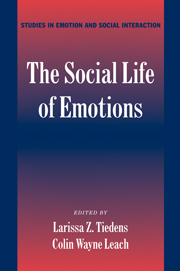Book contents
- Frontmatter
- Contents
- Acknowledgements
- List of Contributors
- The Social Life of Emotions
- Introduction: A World of Emotion
- PART I THE INTERPERSONAL CONTEXT
- PART II THE INTRAGROUP CONTEXT
- 6 Emotional Contagion
- 7 The Emotional Convergence Hypothesis
- 8 Emotional Variation in Work Groups
- 9 Inside the Heart of Emotion: On Culture and Relational Concerns
- 10 Objectification Theory and Emotions
- PART III THE INTERGROUP CONTEXT
- Index
- References
6 - Emotional Contagion
Religious and Ethnic Hatreds and Global Terrorism
Published online by Cambridge University Press: 01 April 2011
- Frontmatter
- Contents
- Acknowledgements
- List of Contributors
- The Social Life of Emotions
- Introduction: A World of Emotion
- PART I THE INTERPERSONAL CONTEXT
- PART II THE INTRAGROUP CONTEXT
- 6 Emotional Contagion
- 7 The Emotional Convergence Hypothesis
- 8 Emotional Variation in Work Groups
- 9 Inside the Heart of Emotion: On Culture and Relational Concerns
- 10 Objectification Theory and Emotions
- PART III THE INTERGROUP CONTEXT
- Index
- References
Summary
“Why can't the Palestinians and Israelis craft a peaceful solution to the current crisis?” political commentators ask. To many, the accords seem so straightforward. In the end – whether the peace process takes 1 year, 10 years, or 1,000 years – Palestinians and Israelis must find some way to share the Promised Land. Both will have to sacrifice the cherished conviction that they (and only they) are the rightful inheritors of the lands of the Ken'ites and the Ken'izites, the Kad'mon-ites and the Hittites, the Per'izzites and the Reph'aims, the Am'or-ites and the Canaanites, the Girgashites and the Jeb'u-sites …(for a discussion of prevailing views, see Bickerton & Klausner, 1998; Friedman, 1995; Said, 1979). And yet the killings go on.
The Palestinians and the Israelis are not the only peoples who find themselves swept up in “perplexing” political, religious, and ethnic conflicts. In the past decade, the world has witnessed a plethora of the horrific: suicide bombers, mass murder, genocide, crimes against humanity, and global terrorism. We have only to speak the names – “Serbia and Bosnia,” “Northern Ireland,” “Cambodia,” “Rwanda,” “Palestine and Israel,” and the “World Trade Center” – to despair.
Social psychologists have devoted a great deal of thought to unraveling the mysteries of the “psycho-logic” that allows good people to commit staggering wrongs – to engage in orgies of torture and killing (see Reich, 1990). Theologians parse the promises of the Bible, the Torah, and the Qur'an.
- Type
- Chapter
- Information
- The Social Life of Emotions , pp. 129 - 143Publisher: Cambridge University PressPrint publication year: 2004
References
- 10
- Cited by



